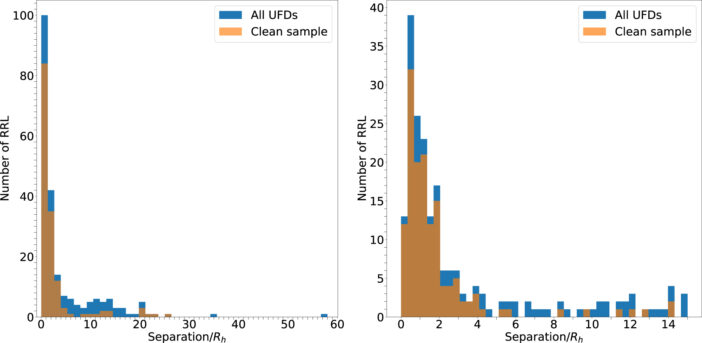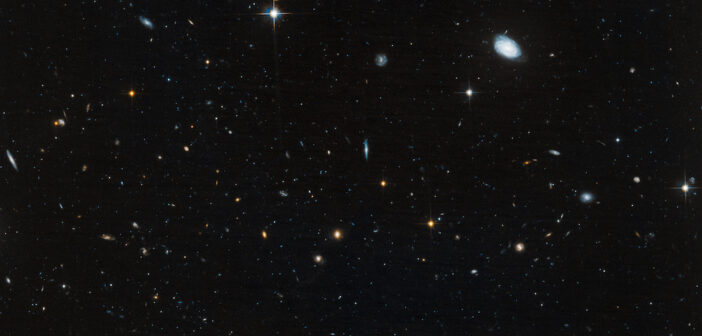Editor’s Note: Astrobites is a graduate-student-run organization that digests astrophysical literature for undergraduate students. As part of the partnership between the AAS and astrobites, we occasionally repost astrobites content here at AAS Nova. We hope you enjoy this post from astrobites; the original can be viewed at astrobites.org.
Title: Extended Stellar Populations in Ultra-Faint Dwarf Galaxies
Authors: Elisa A. Tau, A. Katherina Vivas, and Clara E. Martínez-Vázquez
First Author’s Institution: University of La Serena
Status: Published in AJ
The Runts of the Galaxy Litter
The first galaxies formed only a few hundred million years after the Big Bang. Galaxies start out small, then grow by pulling in the surrounding gas and merging with each other. Most galaxies today are about 100,000 light-years across (roughly the size of the Milky Way), but some of the largest galaxies can be millions of light-years across. At the other end of the scale, we have dwarf galaxies, which are closer to 10,000 light-years across. As a result of their small size, dwarf galaxies have few stars and aren’t very luminous. Dwarf galaxies often orbit larger galaxies as satellites, similar to how moons orbit planets and planets orbit stars.
Dozens of dwarf galaxies have been discovered orbiting the Milky Way. You’ve likely already heard of the most famous of these — the Large and Small Magellanic Clouds, which are visible from the Southern Hemisphere. However, most of the dwarf galaxies orbiting the Milky Way are much smaller and dimmer than the Magellanic Clouds, making them difficult to make out with the naked eye. Astronomers often identify dwarf galaxies by finding a collection of stars and gas that moves together with star-mapping surveys like Gaia. Ultra-faint dwarf galaxies are particularly difficult to detect because they have so few stars; where a normal dwarf galaxy may have millions or billions of stars, ultra-faint dwarfs usually only contain thousands or tens of thousands. Ultra-faint dwarf galaxies lack stars because most of the mass in these galaxies consists of dark matter.
A topic of discussion among astronomers studying dwarf galaxies is how large these galaxies can be. The size of a dwarf galaxy can be determined by measuring the distance to the farthest stars that belong to the galaxy. Stars located near the edges of dwarf galaxies would belong to a stellar halo, which contains older stars. Stellar halos around dwarf galaxies are incredibly difficult to detect because they contain so few stars, so it is not clear how often ultra-faint dwarfs host stellar halos or what the halo properties are. One way to trace stars that may belong to stellar halos is with RR Lyrae variable stars. In addition to being older stars, meaning we expect them to be more common in stellar halos, these stars are a type of “standard candle,” meaning they have a known luminosity or energy output. RR Lyrae stars pulsate, and the variation in their luminosities is related to the period of their pulsations, so astronomers can infer an RR Lyrae star’s luminosity by measuring changes in its brightness. Previous studies have attempted to look for stellar halos in ultra-faint dwarfs with RR Lyrae stars, but this method was challenging to carry out before the data and telescopes that became available in the last few years. The authors of today’s article are continuing the search for RR Lyrae stars in the outer reaches of ultra-faint dwarfs to probe the presence of extended stellar populations and stellar halos.
Finding Ultra-Faint Dwarfs
The authors compiled a list of known ultra-faint dwarfs around the Milky Way, many of which were discovered by the Dark Energy Survey (DES). They also compiled a sample of RR Lyrae stars that were detected by a series of stellar surveys, including Gaia, the Zwicky Transient Facility (ZTF) surveys, DES, and the first Panoramic Survey Telescope and Rapid Response System (Pan-STARRS) survey.
But how do astronomers actually determine which stars belong to an ultra-faint dwarf, especially when these galaxies contain so few stars? Astronomers use a couple of quantities to determine this. First, they are looking for a collection of stars that are in the same area of the sky and are all roughly the same distance from Earth. The authors measure the distance to each star by using the star’s luminosity, since it is related to the distance by the equation L = 4πFd2, where L is the luminosity (total power emitted), F is the flux (power per unit area detected at Earth), and d is the distance. Again, astronomers know the luminosities of these stars because the luminosity of an RR Lyrae star is related to how quickly its light output varies. By comparing this known luminosity to how much light they actually detect, astronomers can estimate the distance between us and the RR Lyrae star.
The next main variable the authors use is proper motion, which is a measurement of how quickly an object moves across the sky. A group of stars with similar proper motions are likely moving together, which is necessary for the collection to be called a dwarf galaxy. Astronomers consider the angular distance between each RR Lyrae star and the center of the dwarf galaxy. Then, they use the distances and proper motions they measured to determine if that RR Lyrae star belongs to the dwarf galaxy or the Milky Way.
Lastly, we need to discuss a quantity called the half-light radius, which the authors denote by Rh. The half-light radius is the radius out to which half the light emitted by a galaxy is contained. Since galaxies don’t have clear edges, the half-light radius provides a useful scale for measuring galaxy sizes. Note that the full radius of a galaxy isn’t 2 Rh since galaxies are brighter in the center and dimmer near the edges. The authors are looking for RR Lyrae stars that are several half-light radii from the centers of their ultra-faint dwarfs, which is where they believe the stellar halos would exist.
Living on the Edge
The authors identify more than 100 RR Lyrae stars in ultra-faint dwarfs from the surveys mentioned above and find that nearly half of the ultra-faint dwarfs contain at least one RR Lyrae star. Some examples of the RR Lyrae stars and their locations in the galaxies are shown in Figure 1.

Figure 1: A sample of ultra-faint dwarf galaxies and their associated RR Lyrae stars. Symbols correspond to the catalog that the star’s position comes from, and the contours represent different radii. Note that some of the stars for the Bootes dwarf galaxies may actually belong to the Sagittarius Stream, which is a part of the Milky Way. [Tau et al. 2024]
A more comprehensive showcase of the RR Lyrae stars is highlighted in Figure 2. While most RR Lyrae stars (and, therefore, most stars) are expected to be within 2 Rh of the center, several have been found well beyond this distance. This again highlights that RR Lyrae stars can be located beyond the main body of the ultra-faint dwarfs in what are likely stellar halos.

Figure 2: Histograms of RR Lyrae stars and their distances from the center of their ultra-faint dwarf (UFD) host galaxy in units of Rh. Blue represents all RR Lyrae stars, and orange represents a cleaned sample that has removed stars from ultra-faint dwarfs for which the authors are concerned about contamination (e.g., stars in the Bootes dwarf galaxies due to contamination from the Sagittarius Stream). The right panel is a zoom-in of the left panel, focusing on distances of up to 15 Rh. [Tau et al. 2024]
Original astrobite edited by Alexandra Masegian.
About the author, Brandon Pries:
I am a graduate student in physics at Georgia Institute of Technology (Georgia Tech). I do research in computational astrophysics with John Wise, using machine learning to study the formation and evolution of supermassive black holes in the early universe. I’ve also done extensive research with the IceCube Collaboration as an undergraduate at Michigan State University, studying applications of neural networks to event reconstructions and searching for signals of neutrinos from dark matter annihilation.

